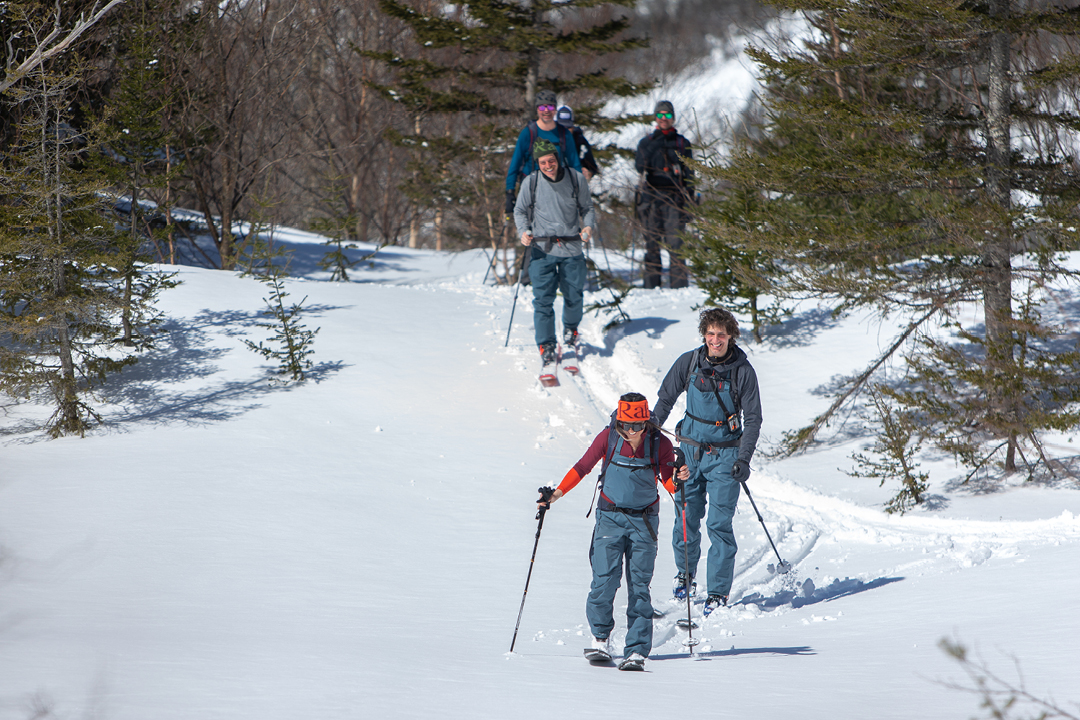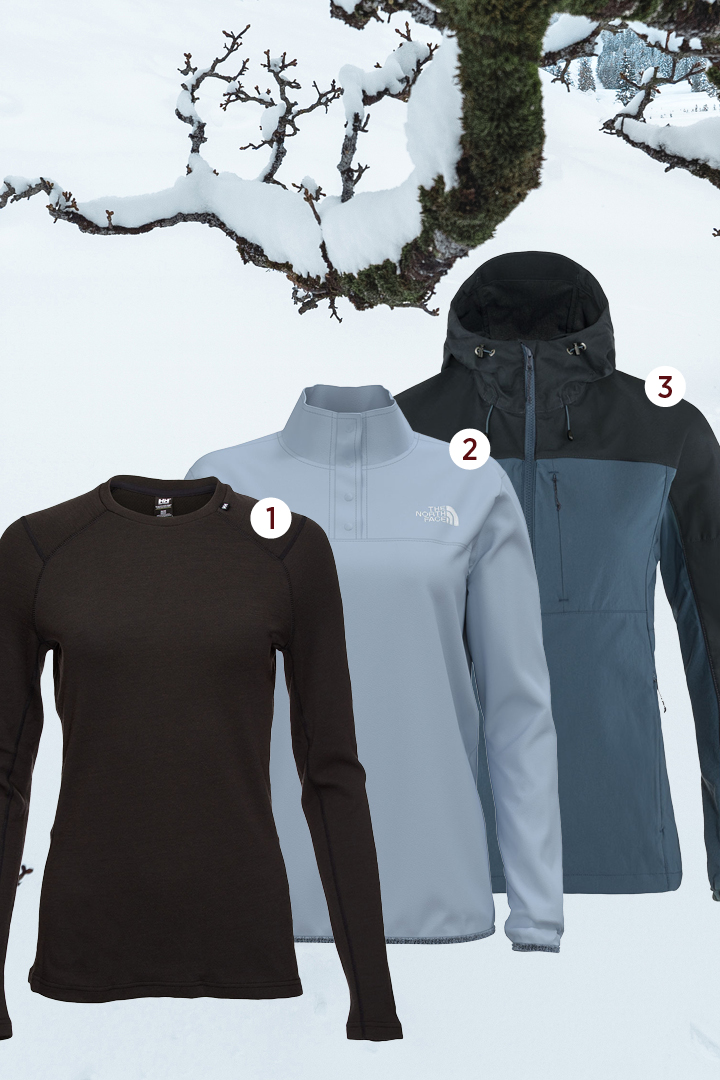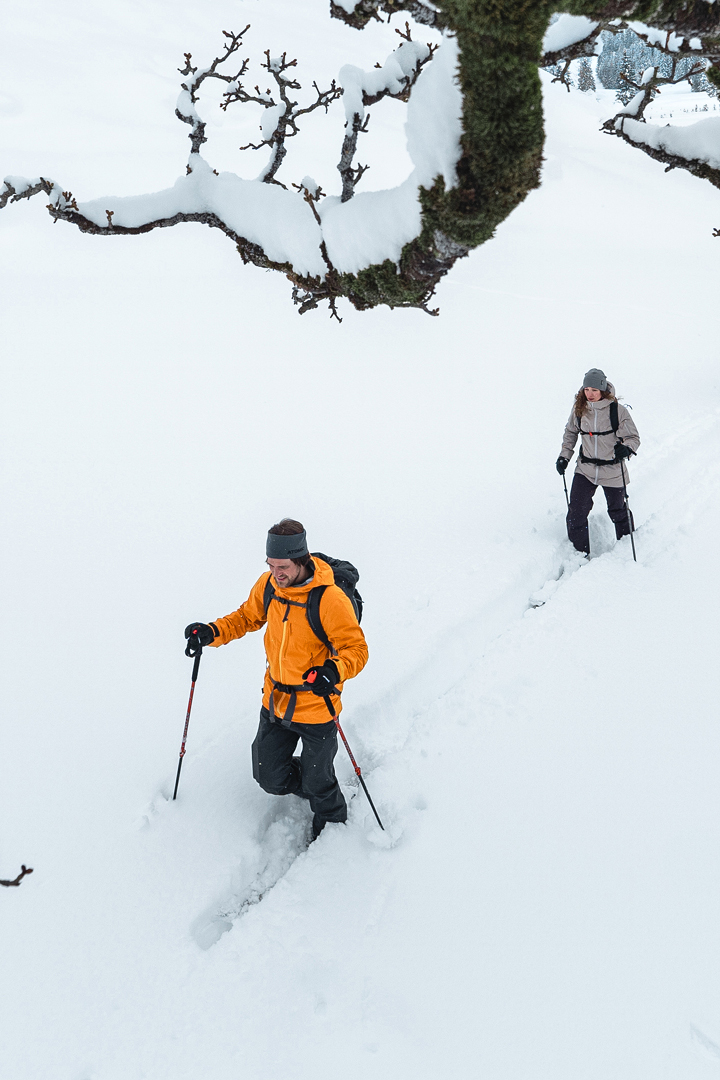How to prevent and treat foot blisters
Outdoor Activities | March 28, 2024
SAIL
November 19, 2021

To get to the best powder areas while alpine touring, you have to start by climbing the mountain. You will quickly realize that the human body produces a lot of heat during climbs. It is therefore imperative to manage your body heat by ventilating and removing layers of clothing as soon as you start to overheat, as sweat and humidity are the enemies of the ski enthusiast. Let’s take a closer look at the subject.
Article written by Guillaume Roy, outdoor reporter.
Alpine touring is not just about getting the right basic equipment – boots and bindings, climbing skins and alpine skis – and hitting the best locations.
You’ll also need to dress well to wick away the excess moisture and sweat generated by the climbs without neglecting to preserve your body heat by following these three tips:
Take this opportunity to shop for the right alpine touring clothing.

As your body warms up, you can remove one or more layers, such as your Gore-Tex outer shell, and your mid-layer, as needed, to bring your body temperature down.
On high altitude ski expeditions, even if it is -20°C, it is not uncommon to climb the mountain with only a base layer on your back to stay dry.
Remember to wear three layers of clothing for the upper body: the base layer, the mid-layer and the shell (also called the outer layer).
For the base layer, for both the upper and lower body, choose clothes that allow moisture to be wicked away and that dry quickly, such as merino wool or fleece. Avoid cotton at all costs, as it dries very poorly.
Take the time to open all the hatches to ventilate. Unless it’s very cold, just put on a pair of tights under a shell.
When it comes to the middle layer, synthetic fiber sweaters or down jackets offer the best performance to keep you warm. However, once wet, down loses its insulating capacity.
Finally, equip yourself with an outer layer that will protect you from the elements, such as rain, snow and wind. Tri-ply Gore-Tex shells are the best option, as they are waterproof and breathable.
The multi-layer system also applies to the head and hands. Depending on the temperature, you can wear either a warm layer (balaclava and warm gloves) or a colder layer (tuque and thin gloves), or all layers at once if it is very cold.
It is very useful to carry an extra pair of gloves and a dry tuque or balaclava for your descent.
To stay warm, no matter what the temperature is outside, pack hand and foot warmers, as they may prevent frostbite or help a friend who is very cold.

The models that offer an opening in the back are particularly practical to have access to your equipment more easily. A net on the front of the bag is also practical to put your helmet on during the climbs.
You now have all the basic knowledge on staying comfortable and effectively managing your body temperature when alpine touring. Before you head out, we provide you with a few suggestions of brands and products that winter sports enthusiasts rely on for their outdoor adventures.
Inspired by the mountains and the people who love to climb them, RAB creates high-performance, durable products that are perfectly adapted to the great variability of winter weather. These include base layers, soft shells and a number of jackets designed specifically for alpine touring. The Xenair Alpine jacket, for example, is strategically insulated to provide plenty of warmth to certain areas of the body, while effectively ventilating those that tend to overheat. Its lighter and even more breathable version, the Xenair Alpine Light jacket, is ideal for layering and makes an excellent mid or outer layer.
Mountain Hardwear believes that performance is all about comfort, protection from the elements, temperature regulation and humidity control. No wonder the brand’s clothing is perfectly suited for alpine touring. Among these are practical and comfortable base layers such as the Chockstone leggings and the Mountain Stretch sweater, which keep you warm while offering a good level of breathability. The brand also offers compressible clothing, including the Glenn Alpine jacket and the Compressor pants, which fit easily in your backpack to serve as a change of clothes or an extra layer for descents, stops or sudden drops in temperature.
Well-known in the ski world, Peak Performance combines functionality and simplicity to create high-quality clothing that stands the test of time and resists extreme weather conditions. The Vertical and Gravity pants, for instance, make excellent outer layers thanks to their Gore-Tex composition and the presence of openings to allow ventilation of warm areas. The brand also offers warm and comfortable mid-layers — including the Chill sweater —, which have the advantage of drying quickly and wicking moisture.
In addition to space for your clothes, you might want to opt for a specialized backcountry and alpine touring bag that contains compartments designed to store safety equipment, such as a shovel, communication device, and avalanche victim device (AVD).
Alternatively, you can purchase a separate safety kit and slip it into your backpack when venturing into high avalanche potential terrain.
In any case, you should always carry this equipment and take a course on how to use it.
For even more safety, carry a small inflatable mattress, which can isolate an injured person if an incident occurs.
Finally, keep a lighter in your backpack, as the greatest danger is the cold.
To keep yourself comfortable and dry when transitioning between ascents and descents, and for eating outdoors, consider carrying an extra insulating jacket. This piece of gear will also come in handy to keep you warm if an injury occurs. Don’t forget to add a second pair of socks, a toque and additional gloves. If space permits, you will also want to bring another vest if needed.
Make sure you have space to carry a lunch, snacks and water. Be sure to calculate your water intake to ensure you don’t run out; you should bring at least 1.5 to 2 liters of water, the minimum amount you should drink on a normal day without physical effort. Also remember to drink enough water before you go skiing.
Safety is the most important aspect of high road skiing. Since you’ll be skiing in remote areas or mountain valleys where cell service may not work, you need to make sure you have a reliable means of communication to reach help if an accident occurs. A portable radio, satellite phone or a geolocation and messaging beacon are good tools when you are out of cell phone range. At the same time, make sure you know where you can access the cell phone network on the mountain and make sure you charge your cell phone and keep it warm (stick a hand warmer on it if it runs out of power in the cold).
Water management can quickly become a problem in the winter, especially in the coldest weather. The tube in your hydration pack will freeze even if it is protected by insulation and the water in your water bottle will become icy, even frozen. To keep yourself hydrated, bring an insulated container filled with water or your favorite hot beverage; coffee, tea, hot chocolate, chicken broth, etc. A comforting treat that will keep you well hydrated, no matter what the conditions.
with inside pockets for your skins (skin pockets) or a snow skirt, which will keep them in place inside your jacket. By keeping your climbing skins warm, it will be easier to stick them to your skis and they will not come in contact with other fabrics, dust, etc.
Above all, ski safely and ethically, leaving no tracks behind you… except for your skis.